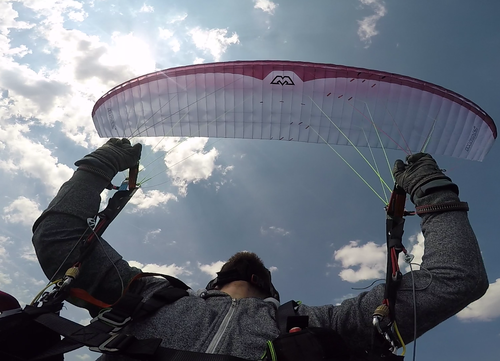Muse 4 - 28 |
|||||||||||||||||||||||||||||||||||||||||||||||||||||||||||||||||||||||||||||||||||||||||||||||||||||||||||||||||||||||||||||||


|
|||||||||||||||||||||||||||||||||||||||||||||||||||||||||||||||||||||||||||||||||||||||||||||||||||||||||||||||||||||||||||||||
Instability rating |
|||||||||||||||||||||||||||||||||||||||||||||||||||||||||||||||||||||||||||||||||||||||||||||||||||||||||||||||||||||||||||||||
|
|||||||||||||||||||||||||||||||||||||||||||||||||||||||||||||||||||||||||||||||||||||||||||||||||||||||||||||||||||||||||||||||
Glider characteristics |
|||||||||||||||||||||||||||||||||||||||||||||||||||||||||||||||||||||||||||||||||||||||||||||||||||||||||||||||||||||||||||||||
|
Launch preparations: easy
launch characteristics: balanced, climbs constantly, no guidance necessary, good feedback during inflation, little braking required, slows before zenith, tends to stall during control check
asymmetric collapse: canopy colllapses at high angle to leading edge, moderate dynamics, total course change 180-270°, (3), fast course change rate, marked forward pitching 60-75°, (4), high height loss 40-49 m, (3), moderate sink velocity 15-19 m/s, (2), collapse on opposite wingtip with course change <90°, (4), G-Force < 2,5 G, (1)
Frontal collapse: marked pitch backwards 45-60°, moderate pitch forwards 30-45°, moderate dynamics, no course change, (1), variable recovery behaviour, at times immediate, at times delayed, automatic recovery, (3), usually symmetric recovery, horseshoe, wingtips at front, immediate return to normal airspeed, moderate height loss 30-39 m, (2), moderate sink velocity 15-19 m/s, (2)
Spiral dives: moderate sink velocity increase, Moderate G-Force 3,5- 4.0 G, (2), Sink velocity after 720° <14 m/s, (1), Moderate maximum sink velocity < 18 m/s, (2), sink velocity increase < 3 m/s on brake release, (1), Course change 180-360° after spiral exit, (2), moderate height loss during recovery 30-60 m, (2)
B-Stall: normal force required, marked pitch backwards 30-45°, marked pitch forwards 30-45°, stable sink phase, low deformation tendency, immediate return to normal airspeed, 8-10 m/s, height loss on recovery < 20 m
big ears: simple initiation, stable flight phase, immediate automatic recovery, Vsink unaccelerated 2,5-3 m/s, Vsink accelerated 3,5-4 m/s, Vunaccelerated 0-3 km/h less than trimspeed, Vaccelerated 5-8 km/h faster than trimspeed
Steering behaviour: balanced, 70 cm brake travel range, very noticable brake pressure increasse, normal stall point, easily identifiable |
|||||||||||||||||||||||||||||||||||||||||||||||||||||||||||||||||||||||||||||||||||||||||||||||||||||||||||||||||||||||||||||||
Notes |
|||||||||||||||||||||||||||||||||||||||||||||||||||||||||||||||||||||||||||||||||||||||||||||||||||||||||||||||||||||||||||||||
|
TakeOff The glider is easy to prepare. The lines and risers are easy to check. After the impuls of the pilot, the glider climbs nice and without any additional pilotsupport. The glider slows down by it self above the pilot. During the controlphase, the pilot has to act very sensitive with the brakes to prevent a stall. In the beginning of the accelerationphase the pilot has to act very sensitive, that the glider has time to follow the acceleration of the pilot. Air Even that the canopy shows a stable and hard feeling, the glider shows a nervös behavior in thermals and turbulences. Asymetric Collapse Collapses were hard to pull. Glider collapses very surfacedeep with a steep collapse angle. Dynamic pitchbehavior. Shockreinflations generate a bit of additional dynamik and the lead to a additional Collapse on the same side. The glider opens between 90° and 80° with additional turning of around 90°. Maximum change of direction was 270°. Front Collapse Callapses were hard to pull. Glider was very collapseresistant in the middlepart of the canopy which leads to a delay in deformation. The wingtips show a complete different behavior. They are easy to collapse and a fast recovery. This combination leads to horseshoe. Spiral Spiral was easy and good to control. No stable Spiral B-Line-Stall Strong pitch during entry and exit. Tendency to horseshoe at maximum pull of B-Lines. BigEars Easy |
|||||||||||||||||||||||||||||||||||||||||||||||||||||||||||||||||||||||||||||||||||||||||||||||||||||||||||||||||||||||||||||||
Rating |
|||||||||||||||||||||||||||||||||||||||||||||||||||||||||||||||||||||||||||||||||||||||||||||||||||||||||||||||||||||||||||||||
|
Safety class 4 This class of paraglider reacts demandingly to one or more of the following manoeuvres: frontal collapse, asymmetric collapse or spiral dive.Demandingly means that the above manoeuvres result in marked dynamic reactions from the glider and/or large height losses. Advanced piloting skills which need to be regularly practised, together with good personal reaction times are required to safely fly this class of gliders. Basic recovery techniques for ending a manoeuvre are not sufficient to maintain control, reduce height loss to a minimum and prevent subsequent critical reactions. Pilots should be able to recognise the onset of the above manoeuvres and be able to prevent or minimise their effects through immediate and precise pilot inputs. Additional experience such as regular ground handling and SIV training is required to safely fly gliders of this class. Special training or pilot skills which exceed standard training may be required for the safe performance of emergency descent techniques. Gliders of this Safety Class are not suitable for beginners, irregular flyers or low-airtime pilots. |
|||||||||||||||||||||||||||||||||||||||||||||||||||||||||||||||||||||||||||||||||||||||||||||||||||||||||||||||||||||||||||||||

